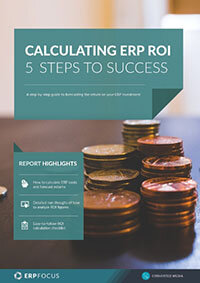How to Calculate Costs for ERP Return on Investment
The costs associated with calculating an investment return on ERP are not usually as straightforward as, say, determining the costs of buying a piece of capital equipment. There are three things that can make it complicated:
1. The ERP software may not have a simple set price. It is likely the software has a list price, and you negotiate a discount from list. The discount might be variable by module. The price might be based on the number of user licenses, adding another variable. There may be IT infrastructure requirements (database servers, upgraded PCs) that aren’t really part of ERP, but have to be included since they are the result of ERP.
2. Maintenance fees: these are the ongoing annual fees charge by an ERP software vendor to provide support and ongoing development to the software product. The fees are generally expressed as a percentage (typically between 12%-25%), and applied to the cost of the software as calculated in number 1, above. Over the course of time, obviously, maintenance fees exceed purchase price in the total cost of ownership.
3. Implementation expense: Depending on the size and approach to ERP implementation, this cost can easily exceed the costs of software and maintenance many times over. There are generally two primary components of implementation costs: ERP implementation consulting manpower and internal manpower. Seek high-level financial advice on how to handle this cost in the ERP ROI calculation. The argument can be made that internal manpower is not really a cost that needs to be justified; the money would have been spent either way.
How Long Should You Calculate Forward?
The big question mark for your calculation of ERP return on investment is the number of years over which to accumulate costs (and benefits). This choice may be made based on a preselected hurdle rate (“we want to see what the ROI is at five, seven and nine years”). The choice may be made based on an expected product life cycle, which might be twelve or fifteen years. The choice might be made based on accounting depreciation rules, which would only be five years. Choose a number of years for the calculation is that is very transparent to everyone (consider putting the number of years as a very visible note on every analysis document). Make sure that everyone involved in a calculating or decision-making role understands the directional impact of choosing a different number of years.
Clearly, some good judgment is required when calculating costs of ERP. The only right approach – even if it means an unflattering return – is to be seen as being as fair and impartial as possible. If you are seen as being to either side of fair, then you will be judged to have a personal agenda, and the financial analysis will be shaded in that light. Be realistic, try to think broadly, and let the numbers speak for themselves.
Free white paper

ERP Implementation: 9 steps to success
The 9 proven steps you should follow when implementing ERP

Featured white papers
Related articles
-

28 cost elements to include in your ERP TCO calculation
With differing definitions and more hidden costs than you can shake a stick at, ERP TCO can be a ...
-

CMMC Compliance: What Aerospace and Defense Manufacturers Need to Know
Key insights on CMMC compliance, deadlines, and securing DoD contracts with CMMC 2.0 certificatio...
-
![Three direct links between ERP and manufacturing revenue [image by Snowing on Freepik] Three direct links between ERP and manufacturing revenue [image by Snowing on Freepik]](/pictures/W1siZiIsIjIwMjUvMDEvMjAva2ZwYjAzb3gzX1RocmVlX2RpcmVjdF9saW5rc19iZXR3ZWVuX0VSUF9hbmRfbWFudWZhY3R1cmluZ19yZXZlbnVlX2ltYWdlX2J5X1Nub3dpbmdfb25fRnJlZXBpa18uanBnIl0sWyJwIiwidGh1bWIiLCI0MDB4MjY2IyJdLFsicCIsImVuY29kZSIsImpwZyIsIi1xdWFsaXR5IDg1Il1d/Three%20direct%20links%20between%20ERP%20and%20manufacturing%20revenue%20%5Bimage%20by%20Snowing%20on%20Freepik%5D.jpg?sha=b45b02a140cc8680)
Three direct links between ERP and manufacturing revenue
What you need to know to help you achieve a return on your manufacturing ERP investment



